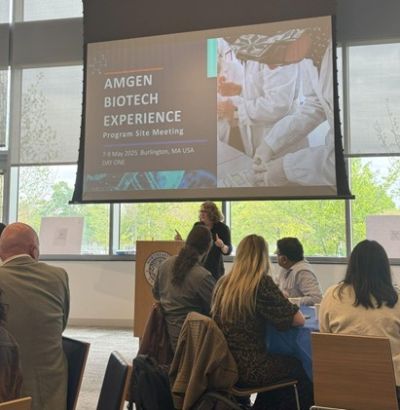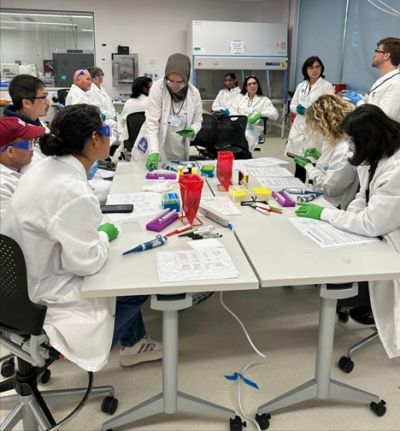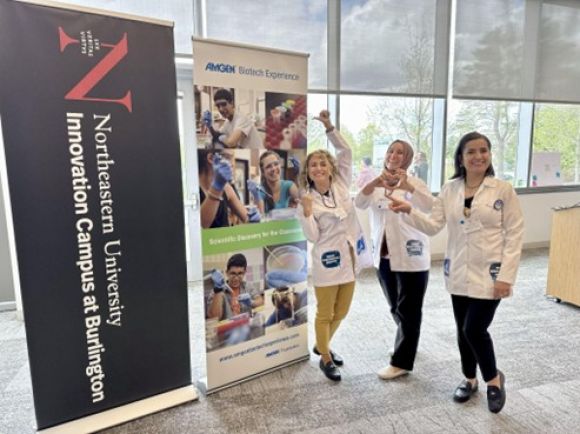These quotes from the ABE All-Staff Meeting in May highlight the unique character of the ABE community: it is not only a community of dedicated educators, but also a group of passionate leaders who consistently go above and beyond in their pursuit of meaningful science learning.
The All-Staff Meeting included some 50 participants from 18 countries, bringing together site coordinators and directors, lab technicians, and ABE program staff. The first in-person meeting of its kind since 2023, the meeting was an opportunity to strengthen the ABE community of practice and share ideas globally. A major component of the meeting was piloting the labs for the Exploring Precision Medicine module, as well as getting feedback on ABE Flex, which modifies ABE labs for situations in which supplies or technology may be more limited.
“It is always breathtaking to me to see the sheer amount of growth within the ABE community,” says Jessica Juliuson, ABE director of community and strategy. “Every time we meet, there are new sites and new faces, with a wide variety of perspectives and approaches to implementing ABE. This meeting allowed us to experience the beauty and strength of our diversity and the impact and reach of ABE firsthand.”

The tremendous output of ideas and feedback from the meeting is already generating new directions for the program. From developing new ways to connect sites between such in-person meetings and launching working groups on specific topics, to refining materials for the new precision medicine module and ABE Flex, and sharing kit preparation hacks, the meeting has kickstarted a new phase of growth and development. “The very best ideas come from our ABE community, and we are so lucky to have such a committed, passionate, and engaged group of people informing what we do,” Juliuson says.
The work to pilot the precision medicine labs was especially helpful in validating ABE’s approach and identifying areas for potential adaptation or refinement. “We were pleasantly surprised by the enthusiasm and also how quickly sites were able to communicate what they needed to do in order to adapt the modules for their own teacher and student needs,” says Tara Bristow, ABE implementation and technical director. This feedback, along with the discussions, sparked ideas for new resources, such as a webinar series to help everyone better understand the Exploring Precision Medicine module.
Participants also expressed excitement about ABE Flex, viewing it as a way to expand global access to the biotech labs. “We wanted a storyline that was woven throughout but that could be easily adapted for an area,” Bristow explains. That landed the development team on the theme of a worldwide water crisis, which would give students the opportunity to apply DNA extraction, pipette art, and the gel electrophoresis lab while using lower tech resources, such as food dyes, compared to more “fancy chemicals” and using simulations or mockups for some components, Bristow says. There was an instant sharing of ideas, she explains, with those from more experienced sites sharing practices that could be incorporated.

Indeed, the ABE community is unique in its “relentless pursuit” of innovation, says Raegan Davenport, ABE community of practice manager. Having worked in education for more than two decades, Davenport says it is commonplace for people to encounter new ideas and immediately dismiss them with comments like “Oh, my kids can’t do that” or “I can’t do that.” But with ABE, it’s different—“there's really a discourse around helping others,” she says, with people “posing a problem or a challenge they're having to the group, and then the group brainstorming those strategies to come up with solutions that support them.”
That type of problem solving can be particularly difficult with such a diverse group of educators from different parts of the world and with ABE sites at varying levels of experience. Davenport especially enjoyed sitting with newer sites to brainstorm ways to keep teachers engaged with one another throughout the year. “In general, scaling up best practices from other sites takes a great deal of input and creativity, but as always, ABE is up to the challenge,” Davenport says.
Connecting with other sites can be a powerful way for the ABE program to grow and thrive. One site leader in the Asia Pacific region commented: “This meeting has revitalized my sense of belonging, community, and wanting to improve what we offer.” Another from the Global South added: “These in-person meetings help so much to keep everything together and enable us to connect and engage on a different level.”
Another critical topic discussed at the meeting was accessibility, which can vary greatly across global sites and can refer to anything from how easily community members from different backgrounds can engage with ABE resources to how students can access the scientific content. One site leader from Europe said: “The most valuable aspect of the meeting was to learn how complex scientific concepts can be made accessible for students.”
Aside from advancing the ABE programmatic goals, the meeting was also a lot of fun. Alongside the roundtable sessions and discussions, for example, there was an “ABE’s Got Talent” event, where participants could showcase their talents. One lab coordinator performed a beautiful Chinese dance, for example, and two participants from Türkiye sang some regional songs. “It just made me think about how the ABE community really is different,” Davenport says. “Having these moments of human connection and emotion was different from a usual work meeting and gave me a different sense of community.”
“Our ABE community members really think of each other as ‘their people,’” Juliuson says. “They have genuine relationships and lean on each other during hard times. They reached out to one another during the global pandemic, they call on each other for help and ideas, and they truly care about the community and feel a sense of belonging. That is not something that is true of every education program that’s out there.”
